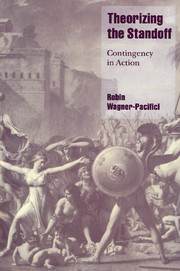4 - The action of standoffs
Published online by Cambridge University Press: 22 September 2009
Summary
10:20 – An informant of established reliability in a position to know, advises that he was informed by American Indian Movement leadership that there would be a meeting at Calico at 15:30 this date and that this is where the action will be.
(From a US Marshal's log, February 23, 1973, quoted in Voices, p. 29, italics mine)We arrive, finally, at the action of the standoff. But in announcing that “finally” I do not necessarily mean to privilege action over temporal and spatial coordinates. It is just that action seems to be where “the action is.” Of course, action is infamously difficult to account for or even to describe. Scholars seek to do it by drawing such distinctions as that between structure and agency or by tracking transformations in things as they take shape and develop in the context of cause/effect and means/ends chains. When one attempts action's actual description, though, time and space immediately move once again onto center stage. No action can be described without them. The simplest physical movement can only occur in ways that are both enabled and constrained by time and space. Such epistemological conundrums return us to the problem articulated in the first chapter of this book: how is it possible to track or trace the present, that time during which action is emerging and has not yet taken definitive (i.e. retrospective) shape?
- Type
- Chapter
- Information
- Theorizing the StandoffContingency in Action, pp. 137 - 213Publisher: Cambridge University PressPrint publication year: 2000



